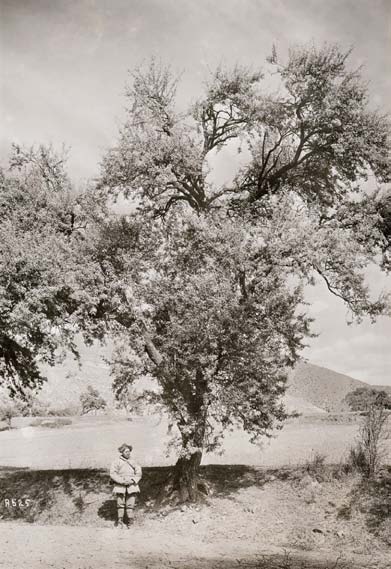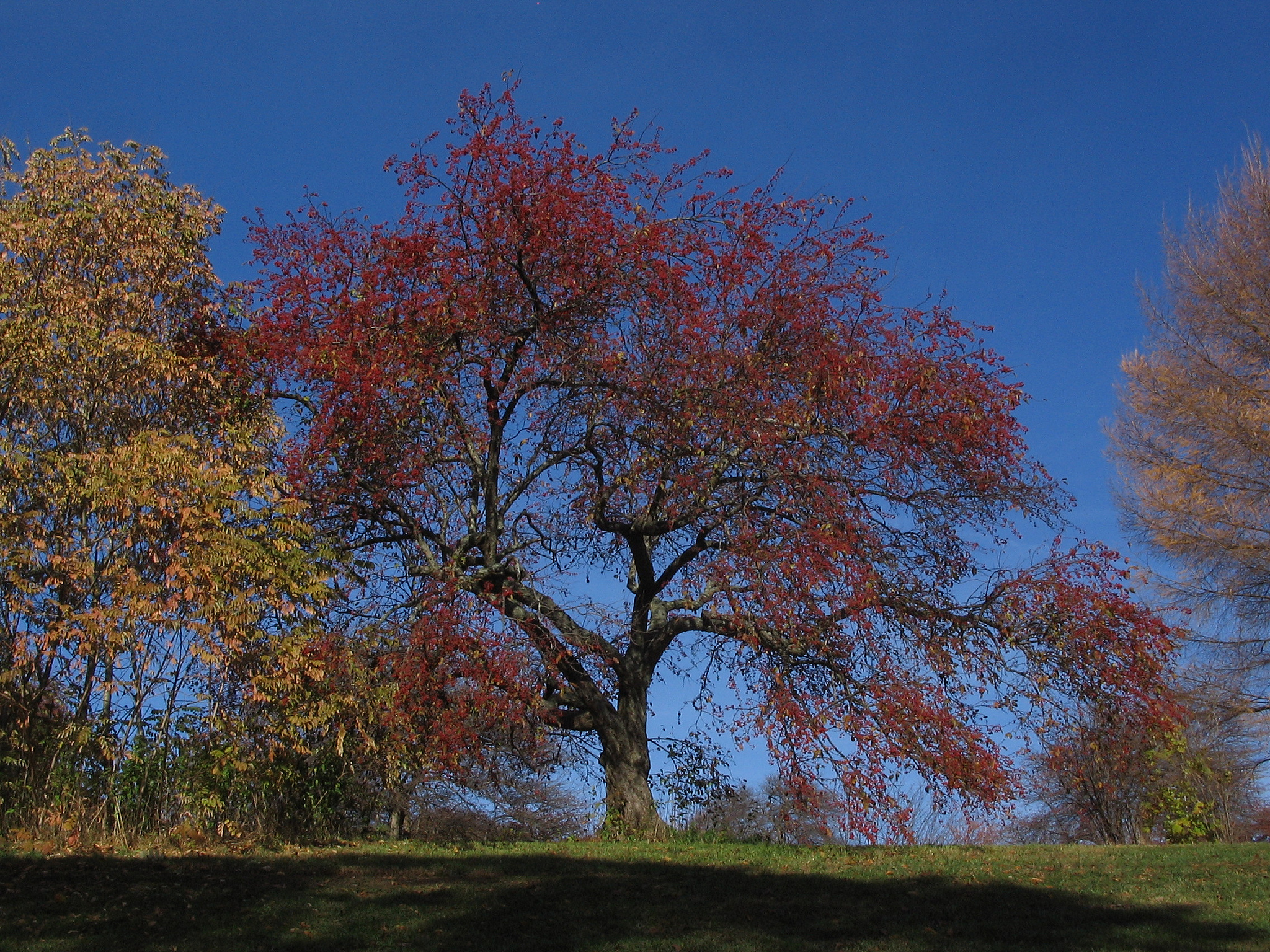In his book Flowering Crabapples: The Genus Malus, the late Father John Fiala (1994) states that “no horticultural institution did as much for introducing and discovering new species, varieties, or special clones [of Malus] as did the Arnold Arboretum.” Those are humbling words coming from such an authority as Father John. As I considered his accolade, I asked myself: What were the drivers that made this all possible?
No doubt there were a number of factors involved in making the Arnold Arboretum “the ‘mother arboretum’ for flowering crabapples” (Fiala 1994). Timing played a critical role in the initial development of the crabapple collection as well as its ongoing use and development. The Arboretum’s founding in 1872 and early rapid expansion of collections coincided with vigorous plant exploration efforts around the world. With respect to Malus, countless taxa new to science were collected from the wild and described, while many others new to North America were introduced from cultivation elsewhere (primarily Europe). Additional introductions of taxa from varying parts of their native ranges ensured that a high degree of genetic variation was present.
Simply having a diverse and sizeable collection of crabapples does not necessarily make it significant, however. The collection’s active use in science throughout its existence put it on the map. Early on, the Malus collection was notably used in the study of taxonomy—the description of new species and their classification. This was followed by the collection’s incorporation into better understanding genetics and cytology, as well as physiology. The collection proved to be of value to applied horticulture as well. Following World War II, as the demand for greater diversity of high-quality landscape plants increased, the products of these plant-breeding efforts (novel hybrids and cultivars) were grown and evaluated at the Arboretum.


Development and scientific use of the collection was made possible by a number of prominent Arboretum personalities. Charles S. Sargent, first director of the Arboretum, knew the research value of a well-documented collection and ensured that the initial development of the Arboretum, including its growing repository of apples and crabapples, would get off on the right foot. He also recognized that Rosaceae was indeed too large a family to occupy its allotted space—the hillside currently known as State Lab Slope near the Forest Hills Gate—which was dictated by the Arboretum’s design based on the Bentham and Hooker sequence of plant families. And so, at the end of the nineteenth century, he designated large expanses on Peters Hill for the cultivation of Pyrus, his beloved Crataegus, and of course Malus. The expansion provided much relief, as numerous new species, hybrids, and cultivars were rapidly being introduced and needed space. Sargent himself collected and introduced new Malus, including the low-growing M. sargentii and the lesser-known but highly ornamental M. tschonoskii, both from his 1892 trip to Japan. Amazingly, the original specimens of these two species, now nearly 120 years old, still grow near the Bradley Rosaceous Collection and represent the Arboretum’s oldest Malus accessions.
Ernest H. Wilson also played the role of explorer and introducer. Plantae Wilsonianae credits Wilson with collecting from some 16 Malus species during his travels in China, several of which were taxa new to science. Perhaps the best of these is Malus hupehensis, the picturesque small tree with a vase-shaped habit that Wilson made numerous collections of during both his Veitch and Arboretum expeditions. In describing its merits, Wilson (in Sargent 1913–1917) notes that “it is very beautiful in spring when covered with light pink flowers, and resembles at this time a flowering cherry rather than an apple tree; the effect of the flowers is heightened by the purple calyx and the purplish tints of the unfolding leaves.”
Alfred Rehder, Arboretum taxonomist, may not have collected and introduced material from the wild, but he certainly applied his shrewd skills of observation and classification in describing and naming scores of the new Malus species and countless infraspecific taxa and hybrids. Hybrids within Malus are quite common, and as the Arboretum’s collection grew and diversified, genes began to mix, hybrids arose, and more discoveries were made.
Perhaps the most ardent scientific user of this botanical petri dish was Karl Sax, former Arboretum director and research scientist at the Bussey Institute. Through the course of much of his Arboretum career, he integrated the Arboretum’s Malus collection into a wide array of studies ranging from polyploidy and apomixis (Sax 1959) to plant physiology (Sax 1957). A byproduct of his many cytology and breeding experiments was an abundance of hybrids, from which Sax was able to evaluate and select a number of crabapple cultivars (Sax 1955). Four prominent ones are ‘Blanche Ames’, ‘Henrietta Crosby’, ‘Henry F. du Pont’, and ‘Mary Potter’. The latter is perhaps his finest introduction and a personal favorite of mine. ‘Mary Potter’—a cross between M. sargentii ‘Rosea’ and M. x atrosanguinea—is low-growing yet spreading, producing an abundance of single white flowers in the spring and bright red fruit in the autumn. Making the story all the more interesting is that it was named after the daughter of C. S. Sargent, and has the Sargent crabapple as a parent.



While Sax may have been the creator of many of the cultivars, it was Arboretum horticulturist Donald Wyman who was their biggest promoter. He lauded their merits throughout the pages of Arnoldia and in his books, and advocated for their use in his lectures and correspondence. And, like Sargent before him, Wyman tapped his extensive global horticultural network to distribute Arboretum selections as well as acquire new taxa to grow and evaluate. In honor of Wyman’s dedication to crabapples, the Arboretum introduced Malus ‘Donald Wyman’ in 1970 to honor him in his retirement. A fantastic selection, it is appreciated for its abundant white flowers in the spring, relatively high disease resistance, and very long-lasting display of brilliant red fruit from autumn through winter. Interestingly, this tree was actually a spontaneous seedling that was first recorded growing on Peters Hill on March 20, 1950. Due to its aesthetic appeal, it was later accessioned and then selected and introduced as the cultivar known today; the original tree still stands. It is ironic that, despite the great efforts of breeding and selection made over the years, the Arboretum’s most important crabapple introduction to date must be chalked up purely to serendipity.



Although the period from Sargent to Wyman may have been known as the “Golden Era for Crabapples” at the Arboretum, work in the collection did not end when Wyman retired. As the Arboretum shifted the focus of its collections policy towards acquisitions of known wild origin in the 1970s and 1980s, novel germplasm from Asia again crossed the threshold. For example, the 1980 Sino-American Botanical Expedition yielded several fascinating collections, including an unusual southern provenance of M. baccata, the Siberian crab, found in Hubei province. In addition to its unusual collection site, this collection (SABE #1298) produces flowers and fruits borne on particularly long pedicels (Spongberg 1991). An amazing trio of this accession, AA 1843-80-D, H, and I, each with outstanding spiral-grained bark, can be found in the Bradley Rosaceous Collection. Other collections of M. hupehensis and M. halliana were made on this momentous expedition as well, significantly increasing the genetic diversity of these species in cultivation. The Arboretum collection continues to undergo development. Recently, we have acquired a number of wild-collected M. sieversii, the progenitor of the cultivated apple found growing in Kazakhstan and neighboring countries.
With respect to the enhancement of fruiting genotypes, the Arboretum’s collection played a noteworthy role, even if it was indirect. Apple scab is a serious fungal disease that damages not just the leaves of trees but also fruits, causing serious economic losses in apple orchards. Resistance can be conferred by the presence of the Vf gene, whose original source came from Malus floribunda selection 821 growing at the University of Illinois. This clone, the most frequently used source for scab resistance in the world (Koller et al. 1994), arose from seed sent from the Arboretum in 1908 to C. S. Crandall, a geneticist at the University of Illinois who was studying inheritance patterns in Malus. However, it was not until the 1940s that the initial crosses were evaluated for disease resistance, and it has only been in the last 30 years that high-yielding cultivars have been introduced through the PRI (Purdue-Rutgers-Illinois) Apple Breeding Program, the most important just in the last few years (Janick 2006). I like this story for a number of reasons. It demonstrates how important it is for the Arboretum to distribute material (plants, seeds, cuttings, tissue, etc.) to researchers to enable their work. It also illustrates the importance of prudence and patience when working with trees—in this case, it has taken nearly 100 years since the original shipment from the Arboretum for the most meaningful dividends in research (in this case superior apple cultivars through one breeding program) to be realized.
Citation: Dosmann, M. 2009. Malus at the Arnold Arboretum: An ongoing legacy. Arnoldia, 67(2): 14–21.
Currently, the Arboretum’s living collection of Malus comprises 455 accessioned plants (about 3% of the total collection), representing 173 unique taxa, 104 of which are cultivars. Development is constant: old lineages of high value are maintained through vegetative propagation, discretionary accessions are disposed of, and new germplasm is obtained. Recent and future renovations on Peters Hill and the Bradley Rosaceous Collection provide wonderful opportunities to grow novel material of both wild and cultivated origin. At the species level, the goal is to possess two to three wild provenances; for cultivars, we will continue to trial new introductions of ornamental selections and will also begin to feature several selections of eating apples. And, of course, the collection will continue to hold many old and historically important selections, including those introduced by the Arboretum.
Michael S. Dosmann is Curator of Living Collections at the Arnold Arboretum.
From “free” to “friend”…
Established in 1911 as the Bulletin of Popular Information, Arnoldia has long been a definitive forum for conversations about temperate woody plants and their landscapes. In 2022, we rolled out a new vision for the magazine as a vigorous forum for tales of plant exploration, behind-the-scenes glimpses of botanical research, and deep dives into the history of gardens, landscapes, and science. The new Arnoldia includes poetry, visual art, and literary essays, following the human imagination wherever it entangles with trees.
It takes resources to gather and nurture these new voices, and we depend on the support of our member-subscribers to make it possible. But membership means more: by becoming a member of the Arnold Arboretum, you help to keep our collection vibrant and our research and educational mission active. Through the pages of Arnoldia, you can take part in the life of this free-to-all landscape whether you live next door or an ocean away.
